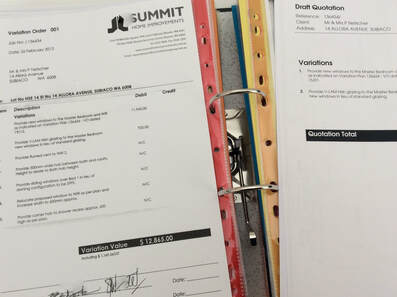"Almost every construction project will have changes and delays. It is vital contractors claim for these so they are not out of pocket or penalised for late completion" On almost every one of the 120 plus construction projects I’ve been involved in we have encountered variations which have resulted in us submitting change order claims. Some were for extension of time due to delays caused by our client. Other variation claims were for increased scope of work, changes in the scope, new specifications or altered project conditions. Many of these variation claims were for millions of dollars and some construction projects almost doubled in value. Yet, in most cases we received the full value of our variation claim or the full extension of time requested. Furthermore, we resolved 99% of the variation claims amicably without resorting to arbitration or legal processes, and we continued to maintain a good relationship with our customers, almost always going on to complete other construction projects with them. When can contractors claim extra costs? So why were we so successful submitting construction change order claims and why do so many contractors’ change order claims end up not being accepted, or if they are it’s only after an expensive and time consuming legal process? Understanding your ClientThe ease of settling a construction change order claim starts with your client, your relationship with your client and sometimes relates to their budget. Some clients are adversarial with their contractors and will dispute every change order submitted. Do you really want to work for these clients? It’s essential you understand your client when bidding for a construction project. Don’t work for those who have a reputation for frequent legal disputes with their contractors. In construction it’s important to know your clients. It could save you. Having a good relationship with your client is essential. If you are adversarial they will take the same approach. Continually talking to your customer keeps them informed so when change orders are submitted they aren’t taken by surprise. If customers think they can trust you and that generally you’re honest with them they’ll often be more receptive to your variation claim. However, if you have a habit of submitting spurious or inflated variation claims and change orders they’re likely to oppose your claims immediately. It helps if your client has money in their budget to pay for change orders. Some clients have no funds to pay change orders and will do everything possible not to pay extra to their contractors. Try and ensure your customer remains within their budget and resist pricing projects where you know their budget is too tight. Understanding your Contract DocumentContractors often get into trouble because they sign and agree to contract conditions which offer them little protection. Before pricing a construction project ensure the terms and conditions of the contract are equitable and that the risks you have to take on are reasonable and manageable. The terms of some contracts may make it very difficult to submit a variation claim or the contract may confer the risk of many variations on the contractor, even when they have little control of these risks. It’s essential you understand the project contract document, that you are familiar with the scope, and know both your obligations and your customer’s. Claims need to be submitted in the time frames in the contract and risk being refused if they aren’t. Don’t start construction projects without a proper contract "Contractors often get into trouble because they sign and agree to contract conditions which offer them little protection." Make your Construction Variation Claim CountI’ve seen many poorly put together change order requests. Some for millions of dollars, yet construction companies often apply minimal time and effort to formulating their variation claims. Some even delegate their claim preparation to junior inexperienced quantity surveyors or contract administrators. Sometimes the construction project manager isn’t even aware a variation claim has been submitted and is blindsided when their client takes offence to a spurious or unsupported claim. I’ve seen variation claims with math errors, spelling mistakes (even incorrectly spelling the client’s name), factual errors, contradictory information, confusing language and unsupported evidence. Construction companies should ensure that a knowledgeable and experienced person is allocated to draft the variation claim (familiar with the contract, the client and the work that’s been done) and that it’s reviewed and checked by the project manager before it’s submitted. Should construction project managers take the lead with variation claims? It’s preferable to keep construction variation claims separate from other variation claims unless they are linked and one impacts another. Combining different variation claims in the same submission can be confusing for your client. Rejection of one variation claim could delay approval of the others included in the submission. "An excellent, concise and very practical guide to successful claims process. This is a no nonsense approach that gets on with it. Packed full of valuable advice for both sides - contractor and employer." What to Include in your Construction Change OrderA properly drafted and well thought out construction change order claim will be hard for your client to refute and it’s likely to be successful. Claims should be clear, concise and logical. Successful change order claims should have:
An introduction to construction variation claims video 16 - Documents required to support your claim Remember to include all of your legitimate and claimable costs. It’s usually difficult to add in extra forgotten costs after you have submitted your claim. It’s unprofessional and will annoy your client. It may even cast doubts on the legitimacy of your original claim. It’s useful to discuss your change order claim with others in your project team to ensure you have the facts set down correctly and that you have referenced the relevant documents and included all of the costs. Get someone to check your variation claim or change order for errors and to see if they can follow your logic. If your logic is flawed, or can’t be easily followed your customer will be inclined to reject it first, before asking questions. Once a change order claim is rejected it becomes more difficult to change their mind and convince your client that you are entitled to the variation. Submitting your Variation ClaimThe client must be notified of project changes and delays as soon as you become aware of them, and certainly within the time specified in the contract document. Failure to do so may mean the contractor loses the right to claim the variation. Are you working for free on your construction project? The variation claim must:
It’s often a good idea to discuss large or contentious variation claims and change orders with your client before submitting them. This not only forewarns the client the claim is coming, but also provides an opportunity to discuss the reasons and the merits of the variation. "Clients with the right knowledge and construction management skills can limit variations on their projects. This book is an excellent guide to manage your projects." Negotiating a Good Outcome for your Change OrderAs much as we all consider our claim as complete, final and non-negotiable it’s almost certain that your customer will come back with questions, counter-arguments and try and negotiate the quantum of the claim down, or even reject it completely. Negotiating a construction variation claim – read this first to improve your success In responding to questions from the client ensure that your replies remain factual and stick to the original arguments presented in your variation claim. It’s easy to introduce other arguments and ideas which could be contradictory or confusing. Reply to all questions in writing referencing the original variation claim. If the questions are raised in a meeting take notes of the questions and your answers, and confirm them afterwards in writing. It goes without saying that all correspondence relating to the construction variation claim needs to be filed where it’s readily able to be retrieved. Some claims can take months to resolve, and if the claim follows the legal or arbitration route it could even take years. Ensure your Variation Claims are SuccessfulIt’s essential variation claims are correctly formulated and submitted in accordance with the contract document. They need to be resolved as soon as possible, preferably amicably and without resorting to protracted legal disputes. However, this shouldn’t mean that contractors don’t fight for their entitlements in terms of the contract. A properly drafted and presented variation claim which is fair will be more readily accepted by your client. Make sure your construction project variation claims are successful. 15 Rules for construction variation claims and change orders How do you ensure your variation claims are successful? This article was first published on the ClockShark website - Get The Industries' #1 Time-Tracking AppRunning a field service or construction business takes coordination and a great team. With ClockShark you get the industries' #1 timesheet app Please share this post Learn more about Construction Project Management"Excellent reference! A combination of theory and actual..very detailed approach." To read more about the author’s books and find out where you can purchase them visit the pages on this website by clicking the links below:
'Successful Construction Project Management: The Practical Guide' 'Building a Successful Construction Company: The Practical Guide' 'Construction Claims: A Short Guide for Contractors' 'Construction Project Management: Tips and Insights' 'Construction Book reviews' To read more about the author visit the page 'Paul Netscher' Want to contact Paul Netscher please enter your details on 'Contacts' Find out how Paul Netscher can help you Order your books from Amazon Order your books from Amazon UK © 2016 This article is not to be reproduced for commercial purposes without written permission from the author.
0 Comments
|
Archives
June 2024
Note: We welcome genuine comments, especially comments that add additional information to the subject matter in the article. We however reserve the right to remove inappropriate comments, which includes comments that have nothing to do with the subject, comments that include inappropriate language, and comments that are an advertisement for a product or company, or which include an advertising link. Comments must be in English. We will not enter into discussion on why a particular comment was removed.
CategoriesCopyright 2016 - The attached articles cannot be reproduced for commercial purposes without the consent of the author.
The opinions expressed in the attached articles are those of the writer. It should be noted that projects are varied and different laws and restrictions apply which depend on the location of the contractor and the project. It's important that the reader uses the supplied information taking cognisance of their particular circumstances. The writer assumes no responsibility or liability for any loss of any kind arising from the reader using the information or advice contained herein. "I have what I consider some of the best books on construction management."
Books are available from: Amazon.com Amazon.co.uk takealot.com kalahari.com Amazon.in Amazon.de Amazon.fr Amazon.it Amazon.com.au Powell's Fishpond uread bokus Amazon.ca Amazon.es Other retail stores Available in paperback or on Kindle "28 YEARS OF CONSTRUCTION PROJECT MANAGEMENT EXPERIENCE, DEVELOPING SUCCESSFUL CONSTRUCTION PROJECT MANAGERS AND BUILDING SUCCESSFUL CONSTRUCTION COMPANIES"
|










 RSS Feed
RSS Feed




